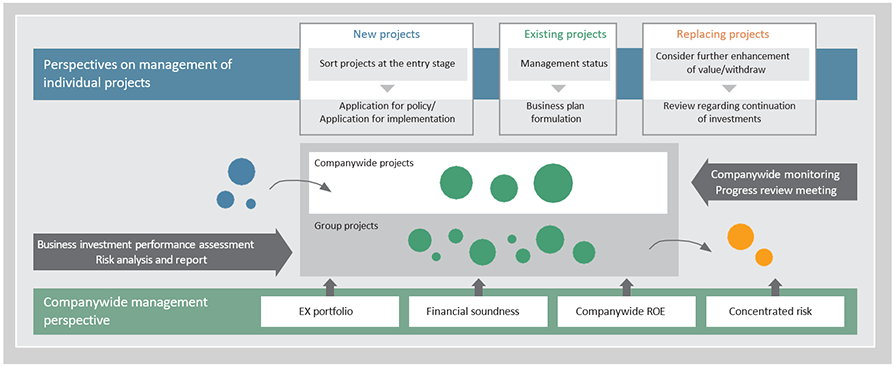Risk Management : Risk Management System
Risk Management System
Overview
MC maintains the following Risk Management System under the aforementioned policy.
- The Executive Committee, a management decision-making body, determines basic policies on risk management as well as individual and integrated risk management items. It also makes decisions about advancing individual projects, and presents matters for the Board of Directors’ agenda based on prescribed standards.
- MC has designated categories of business activity risk corresponding to the details and scale of each risk, including credit, market, business investment, country, compliance, legal, information management, environmental and natural disaster-related risks, and has designated directors in charge and specified departments responsible for each category.
- MC has established and maintains an overall system to review individual projects and internal systems in relation to specific types of risk through deliberative bodies under the Executive Committee including the Investment Committee, the Sustainability Committee, the Compliance Committee and the Human Resources Development (HRD) Committee. Matters deliberated by these committees are presented or reported by the director in charge to the Executive Committee chaired by the President and CEO.
- In order for the Board of Directors to effectively supervise specific types of risk, a system has been established whereby matters deliberated by each committee are reported to the Board of Directors as necessary. Each risk is then broadly classified into financial and non-financial risks, with the effectiveness of each risk management system reviewed and monitored by the Board of Directors on a regular basis each year.
- *The Internal Audit Department, which reports directly to the President and CEO, is separate and independent from the directors in charge and responsible departments mentioned above and handles auditing and risk management.
-
- With respect to individual projects, personnel responsible for the applicable department in charge of a project make decisions within the scope of their prescribed authority after analyzing and assessing the risk-return profile of each project in accordance withcompanywide policies and procedures. Projects are executed and managed on an individual basis in accordance with this approach. Further, in response to the progress of projects or changes in the external environment, MC conducts periodic verification of risk-return profiles.
In addition to managing risk on an individual project basis, MC assesses risk on a consolidated basis with respect to risks that are capable of being monitored quantitatively and manages these risks properly, making reassessments as necessary.
| Risk Type | Director in Charge | Duties Overseen |
|---|---|---|
| Credit risk, market risk, business investment risk, country risk | Yuzo Nouchi | Corporate Functional Officer, CFO |
| Information management risk, legal risk, compliance risk, employee safety risks such as natural disasters/terrorism/emerging infectious diseases, etc, business continuity risk | Yutaka Kashiwagi | Corporate Functional Officer, Human Resources, Global Planning & Coordination, IT |
| Environmental risk | Kenji Kobayashi | Corporate Functional Officer, CSEO |
Risk Management Framework
| Supervising Organization | Matters for Supervision |
|---|---|
| Business Investment Management Department | Business Investment risk and market risk (Investment Return Valuation System, new business investments, actions for existing business investees, transactions by business investees, granting loans/guaranty, acquisition and disposal of fixed assets, mikoshi, acquisition and disposal of non-affiliated investments, etc.) |
| Sustainability Department | Climate risk, etc. |
| Corporate Administration Department (Security & Crisis Management Office) | Risk of natural disasters, etc. (risks related to employee safety, including natural disasters, terrorism, new infectious diseases, and business continuity risks) |
| Legal Department | Compliance risk (litigation/government investigations, laws and regulations, scandals/ compliance issues) |
| Finance Department | Credit risk, Market risk (foreign exchange, interest rate, stock price,foreign exchange mikoshi*, etc.) , Country risk |
| Mitsubishi Corporation Financial & Management Services (Japan) Ltd. | Credit risk (rating systems, conclusion of contracts, trade credits, bailment, payment extension, etc.) |
- (notes)*The above list excludes those items that are related to major risks.
- *The Structured Finance, M&A Advisory Dept. also manages foreign exchange mikoshi.
Responding to Business Investment Risk
To manage business investment risk properly, MC has established a screening process to review and make decisions on new, existing, re-profiling and each other type of projects.
| New projects | Application for policy/Application for implementation | Narrow down new investment and finance proposals by comprehensively evaluating quantitative aspects in terms of the invested capital and its return determined on the basis of the characteristics of each business, in addition to evaluation of qualitative aspects, including consistency with the business strategy of each Business Group, as well as risk locations and countermeasures |
|---|---|---|
| Existing projects | Business plan formulation | Once a year, review subsidiaries and affiliates’ management issues and initiatives as well as MC’s functions and business life cycle |
| Replacement projects | Review regarding continuation of investments | Conduct qualitative and quantitative evaluations of new investment and finance proposals based on the priority order of Business Group strategies and promote a healthy business metabolism |
